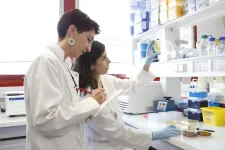“The Global Nitrogen Innovation Center addresses the urgent need to respond to the impending technological innovation to produce ammonia using renewable energy known as ‘green ammonia’,” said Center director Xin Zhang, professor at the University of Maryland Center for Environmental Science. “By doing so, we hope to be able to harness the technological innovation of green ammonia production to bolster clean energy initiatives, combat climate change, and secure food supplies for the future, while minimizing risks of unintended consequences.”
The current industrial ammonia production is heavily energy-intensive and primarily dependent on fossil fuels, contributing 1-2% of global greenhouse gas emissions. In the agricultural sector, green ammonia technology could lead to decentralization of fertilizer production, enhancing fertilizer use and bolstering food production in countries where nitrogen (N) fertilizer accessibility has been limited, thus improving crop production, economic prosperity, nutrition, and food security. It could also enable farmers in industrialized countries to improve the timing and dosing of fertilizer to better match crop needs and thereby reduce N losses. However, more abundantly available N fertilizer could also exacerbate the current severe environmental problems of N losses to air and water from overuse and inefficient use of N fertilizers.
In the transportation sector, particularly the shipping industry, green ammonia is a viable and promising option to replace traditional fossil fuel, but doing so would likely triple the amount of reactive N that humans introduce to the biosphere, exacerbate coastal pollution, and increase emissions of N2O, which is the third most important greenhouse gas (GHG) and the most abundantly emitted stratospheric ozone depleting substance.
“Climate change and nitrogen pollution are two of the most significant threats facing humanity, and they are inextricably connected. The NICCEE will strengthen connections between the scientific and stakeholder communities that care about both issues and accelerate innovations that are effective and beneficial for actors across agri-food and energy systems," said New York University Professor and Chair of the International Nitrogen Initiative David Kanter.
NICCEE will serve as an information hub with state-of-the-art cyberinfrastructure to monitor the lifecycle and effects of nitrogen in agriculture-food-energy systems, an innovation platform to facilitate the co-development of technological and socioeconomic solutions with a broad spectrum of stakeholders, and an education center to nurture the next generation of scientists and innovators championing sustainable and climate-smart nitrogen management.
“The advent of green ammonia, depending on how it unfolds, could either contribute to the solution or exacerbate the problem of inefficient N fertilizer use and N loss to the environment. We need to get ahead of the curve of this impending technological transformation so that the impacts of green ammonia will be guided by excellent agronomic and socio-economic research,” said UMCES Professor Eric Davidson.
The international effort involves collaborators from eight countries, across academia, NGOs, international organizations, government, and private companies, and brings together expertise in biogeochemistry and agronomic science, chemical engineering, complex system modeling, environmental sociology, economics, statistics and data science, coastal ecology and equity in the geosciences, science engagement and evaluation, remote sensing, environmental law and policy, atmospheric modeling, sustainability science, life cycle assessment and translational science.
“The green ammonia process is to harvest solar energy or other renewable energy supplies to produce ammonia without carbon dioxide emission. For example, sunlight can drive conversion of nitrogen and water to ammonia,” said Nianqiang (Nick) Wu, Co-PI and Armstrong-Siadat Endowed Chair Professor at University of Massachusetts Amherst.
“We are looking forward to working with this transnational and transdisciplinary team to address pressing environmental and energy related issues affecting the global nitrogen cycle. Joining forces with stakeholders and researchers in the US, the UK, Morocco, and beyond will allow us to maximize efforts and find solutions for these pressing issues,” said University of Guelph Professor Claudia Wagner-Riddle, lead partner from Canada.
“The Center will enable scientists, engineers, farmers, and other agricultural stakeholders to work together to understand and shape the potential of new, promising technologies. By working with stakeholders as partners, we can help to ensure these green fertilizer technologies can and are achieving social, economic and environmental benefits” said UMCES Assistant Research Professor and Senior Social Scientist at The Nature Conservancy Matt Houser.
“We are delighted to be part of this transnational science programme and to have an opportunity to apply our systems science to better understanding and managing the urgent energy and environmental issues surrounding the need for nitrogen to support production from agroecosystems, but in the context of also needing to reduce trade-offs,” said Professor Adie Collins, science director for Net Zero and Resilient Farming at Rothamsted Research.
The Global Nitrogen Innovation Center for Clean Energy and the Environment is jointly funded by the U.S. National Science Foundation, UK Research and Innovation, and Natural Sciences and Engineering Research Council of Canada. U.S. researchers will be supported by the National Science Foundation up to $5 million over four to five years, while foreign researchers will be supported by their respective country's funding agency with a comparable amount of funds.
NICCEE is part of a Global Center initiative by the National Science Foundation to support international, interdisciplinary collaborative research centers focused on assessing and mitigating the impacts of climate change on society, people, and communities. The centers will also create and promote opportunities for students and early-career researchers to gain education and training in world-class research while enhancing diversity, equity, inclusion, and accessibility.
Lead institutions include the University of Maryland Center for Environmental Science, University of Guelph, Rothamsted Research, New York University, and University of Massachusetts Amherst.
Collaborators include the Africa Plant Nutrition Institute, Agribusiness Council of Indiana, Agriculture and Agri-Food Canada, Ammonia Energy Association, Canola Council of Canada, Chinese Agricultural University, Delaware-Maryland 4R Alliance, Environment and Climate Change Canada, Environmental Protection Agency, Fertilizer Canada, FuelPositive, Harbor Launch, International Fertilizer Association (IFA), McGill University, Mohammed VI Polytechnic University, Nutrien, Ontario Soil and Crop Improvement Association, Pacific Northwest National Lab, The Mill, The Nature Conservancy, United Nations Food and Agriculture Organization (FAO), United States Geological Survey, Universidad Politécnica de Madrid, University of Manitoba, and University of Saskatchewan.
UNIVERSITY OF MARYLAND CENTER FOR ENVIRONMENTAL SCIENCE
The University of Maryland Center for Environmental Science leads the way toward better management of Maryland’s natural resources and the protection and restoration of the Chesapeake Bay. From a network of laboratories located across the state, UMCES scientists provide sound evidence and advice to help state and national leaders manage the environment and prepare future scientists to the meet the global challenges of the 21st century. www.umces.edu
# # #
END






